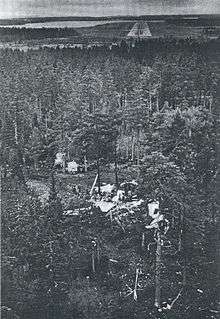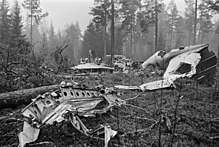Aero Flight 217
Aero Flight 217 (AY217) was a domestic passenger flight from Helsinki to Mariehamn in the autonomous territory of the Åland Islands, operated by the Finnish flag carrier Aero O/Y (since 1968 also officially known as Finnair). On 8 November 1963, the aircraft serving the flight crashed in poor visibility while attempting to land on a non-precision approach at Mariehamn Airport in the municipality of Jomala. Resulting in the death of 22 people out of 25 on board, the crash remains the second most deadly aviation accident in Finland.[1]
 The wreck of OH-LCA short of the runway. | |
| Accident | |
|---|---|
| Date | November 8, 1963 |
| Summary | Controlled flight into terrain |
| Site | Near Mariehamn Airport, Jomala, Åland Islands, Finland |
| Aircraft | |
| Aircraft type | Douglas DC-3 |
| Operator | Aero O/Y |
| Registration | OH-LCA |
| Flight origin | Helsinki Airport |
| Stopover | Turku Airport |
| Destination | Mariehamn Airport |
| Passengers | 22 |
| Crew | 3 |
| Fatalities | 22 |
| Survivors | 3 |
Flight chronology
Flight 217, operated with a Douglas DC-3, was scheduled to take off at 14:50 GMT and travel along the Helsinki-Turku-Mariehamn route from Helsinki Airport.[2]:1 The crew consisted of pilot Pekka Marttinen, co-pilot Pekka Yli-Niemi and flight attendant Marianne Kullberg. The flight departed later than scheduled, at 15:09 GMT.[2]:1 Everything proceeded as planned as far as the stopover at Turku Airport. The aircraft departed from Turku with 21 passengers, three crew members, one deadheading person, 789 kilograms of cargo and 1100 litres of fuel.[2]:1 At this time, the weather was foggy and near Aero O/Y's planning minimal limit that would have cancelled the flight.[2]:2 In Mariehamn, horizontal visibility was slightly worse and thus partially under these limits.[2]:2 According to the flight plan, Stockholm Arlanda Airport in Sweden was reserved as a back-up airport for Flight 217.[2]:2
Nothing unusual was reported via radio during the flight from Turku to Mariehamn, which was flown at 2000 feet. The aircraft was nearing the non-directional beacon (NDB) "MAR" from northwest so that it was aligned for the final approach already in Godby.[2]:2 It flew past the non-directional beacon at 16:57-16:58 GMT and was prepared to land on the runway. However, the aircraft struck trees 1480 meters before the runway and 50 meters before the final approach beacon ("Locator S").[2]:2 The airplane had been perfectly aligned for the runway at the time of the contact. The plane hit the ground after rotating leftwards on its longitudinal axis, landing upside down and immediately catching fire.[2]:2
The flight attendant and two male passengers escaped from the burning wreck before rescuers arrived. Everyone else had died either from impact forces or the fire. After AY217 had not responded to any calls, the flight controller called a major alarm without delay. Rescue work was hindered by foggy weather and poor road conditions in the area of the accident.[2]:2
Mariehamn Airport technical equipment
Mariehamn Airport used two radio transmitters for contacting airplanes: the "MAR" and "Locator S" beacons. The airport was not equipped with an instrument landing system (ILS) or a radar;[2]:8 while ILS equipment had been purchased for the airport two years before the accident, local land disputes postponed their installation.[2]:21 A low-power approach lighting system stretched from 1020 meters before the runway and was powered from the same source as "Locator S" which could mean turning on the lights may have reduced the voltage to the beacon.[2]:8 The area around the beacon, which had the highest obstacle profile, did not have any lights.[2]:8 Contemporary press went so far as to call the landing equipment of the airport a "death trap" after the accident.[3]
Investigation

Investigation after the accident revealed that one deadheading person who was not included on the passenger list was present on the plane. He was a former Aero O/Y pilot and WWII fighter ace Ilmari Joensuu who was allowed to travel in the cockpit by the pilots.[2]:6 Contrary to the speculation in the press following the incident,[4] his presence likely did not have any connection to the occurrence of the accident, according to the investigation report.[2]:20
The official investigation board concluded that the crash happened because of lack of awareness on the part of the pilots, either of the plane's altitude or of its location.[2]:21 The misconception of the altitude could have resulted from the altimeter displaying a wrong altitude or the pilots correcting a known altimeter error the opposite way. Another OH-LCA pilot, captain Tamminen, had informed the investigators that the altimeter had erroneously shown an altitude fifty feet higher than the actual altitude one day before the flight.[2]:22 If this error remained, the pilot might have corrected the 50 feet error in the opposite direction, resulting in an altitude 100 feet greater than was correct.[2]:22 According to the investigation report, this still would not have been enough to hit the trees, but it would have been possible with an additional error in flying even lower.[2]:22 Technical investigation of the altimeter determined that it was also possible that a new malfunction occurred during the flight.[2]:22
The other possibility of mistaken location was supported by statements of other Aero O/Y pilots who claimed that the radio transmitter beacon "Locator S" had given wrong readings to the airplane radio compass.[2]:23 This wrong reading may have given an impression that the airplane had passed the beacon earlier than it did in reality.[2]:23 However, the investigation board stated that it was unlikely as Flight 217 flew very close to the beacon, which meant the signal must have been strong and that the likely reason was the pilots' misconception of the altitude instead.[2]:23
The investigation board recommended that airlines use stricter weather standards than those prescribed by the International Civil Aviation Organization's Obstruction Clearance Limit (OCL).[2]:25 It also criticized the use of NDB-only landing systems and proposed that ILS and GCA equipment would be speedily taken to use at Finnish airports.[2]:25
Wreckage from the aircraft was left in the forest in the vicinity of the airport for nearly 55 years, before being removed in 2018 due to environmental concerns. A memorial plaque was then placed at the site.[5]
See also
- Aero Flight 311, Aero O/Y's fatal accident in 1961
References
- Ranter, Harro. "ASN Aircraft accident Douglas C-47A-35-DL (DC-3) OH-LCA Mariehamn Airport (MHQ)". aviation-safety.net. Aviation Safety Network. Retrieved 2020-07-12.
- "Official investigation board report" (PDF) (in Finnish). Safety Investigation Authority. 1964.
- Junttila, Veli (4 November 2013). "Suomi 1963: Maarianhaminan lentoturma" [Finland 1963: Mariehamn plane crash]. Turun Sanomat (in Finnish). Retrieved 28 September 2014.
- "Turmasta selvinneen lentoemännän haastattelu" [Interview with the flight attendant who survived the accident] (in Finnish). Yle. 21 November 1963. Retrieved 28 September 2014.
- "Minnen från flygkatastrof städades bort" [Memories from the disaster were cleared] (in Swedish). Retrieved 2018-09-05.
External links
- Video footage from the crash site at the Yle Elävä arkisto (in Finnish)
- AirDisaster.com account of the crash (Archive)
- Accident description at the Aviation Safety Network